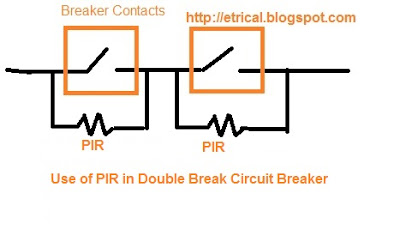Two types of Circuit Breakers are used in 400 kV Switchyard. They differ in only one features i.e. Pre Insertion Resistor (PIR). One type has PIR whereas other has no such provision. Both type of breaker are self-compensating Spring to Open and Spring to Close type. SF6 gas is used as arc quenching medium. The normal pressure of SF6 gas is 6 bar(g).
Figure below shows a typical Grading Capacitor used in Double Break Circuit Breaker.
Purpose of PIR:
PIR is pre-insertion-resistor. This is a resistor of about 200-400 ohms which gets closed before closing the circuit breaker. The sequence is (close order)->closing of PIR->10-12milliseconds->closing of main break.
But while opening, PIR is first disconnected by the Breaker operating mechanism and then i.e. after 10 ms, main contacts of Breaker are opened. The main purpose of PIR is to limit the initial charging current of line. As the charging current of long line will be much more, it is advisable to use Breaker having PIR in long transmission line.
When electrical circuit having capacitance or transformer which can have inrush. Also transformers may have large inrush current. Transmission line (due to its capacitance) is another such circuit.
For closing in such circuit first the PIR comes in circuit to limit the inrush current. When the main contacts close, the current through PIR becomes zero as the shunt path is bridged by main contact.
Purpose of Grading Capacitor:
The purpose of grading capacitors is to ensure uniform voltage distribution in open position. If you mind, the pressure of SF6 gas kept in Breaker of 220 kV Switchyard is 6 bar and that used in 400 kV is also 6 bar. How could this be possible? Assuming that the gap between the main contacts of Breakers used in 220 kV and 400 kV Switchyard are same, when we increased the voltage the pressure of SF6 should also be increased as the Dielectric Breakdown strength of SF6 is proportional to its pressure.
Thing is that when we use Grading Capacitor, the voltage across each contact is distributed uniformly. Thus for Breaker having two contacts i.e. for Double Break Circuit Breaker, the voltage across each contact will be 200 kV and thus 6 bar of SF6 will work fine.
Thank you!



Very useful article.Thank you…
Thank you
Thank you
Thank you.
Very clearly explained. Thank you.
While close, first the main contact will close then arcing contact. Please confirm. It may be typing mistake in your discretion in first paragraph.
First Arching contact closes, then main contact.
Sir where is the grading capacitor. Does it have a physical existence like PIR Is it appearing only because we made it double break for higher voltage application.
It is connected across each of the breaker contact. Please read Grading Capacitor.
Grading caps are found on breakers with more than one break, live tank/air blast breakers can have up to 10 breaks per phase (800kv) and have a grading capacitor for each breaks.
The first picture shown above should have grading capacitors labeled where it shows PIR! not all breakers will have PIR, but all multi break breakers requires grading capacitors.
On live tank breakers, like in the picture above, if there are PIR, then it needs a second set of bottles containing PIR. most will be mounted in parallel with “interrupter of CB” like the grading caps, some can be mounted on top of the “interrupter of CB” in shape of “M” see ABB 550 ELF w/insertion resisters.
Grading caps on dead tank SF6 breakers can not be seen, there are mounted inside of the tank, so are the PIR. See ABB 550 PM w/insertion resisters. The name plate will say if it has PIR
My question is how 200KV is present across one breaker contact and 400KV between two breaker contacts .
This is due to the grading capacitor. For better understanding, kindly read Calculation of Voltage Distribution with Grading Capacitor in multi break Circuit Breaker.